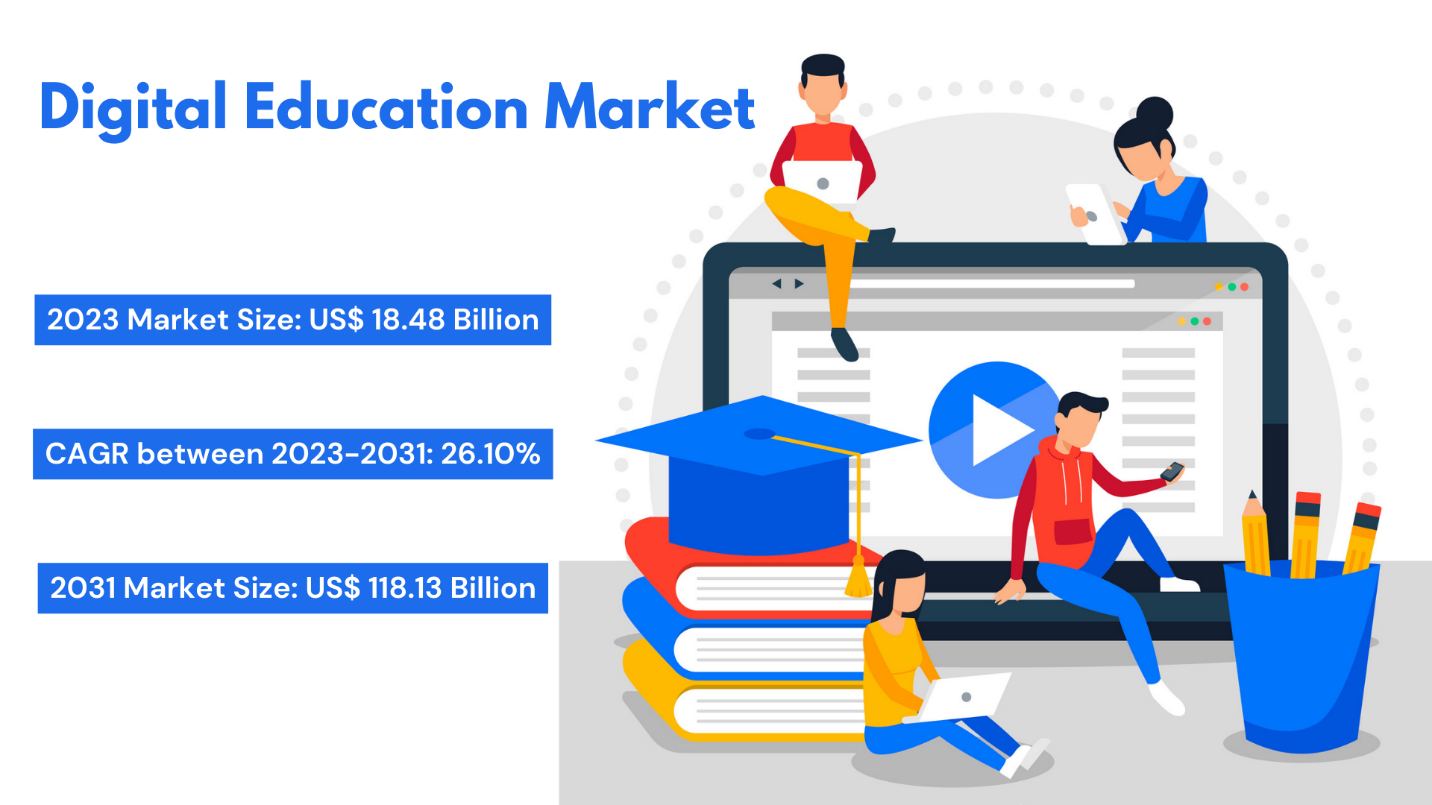Digital Education Market Growth Summary
The digital education market is primarily driven by increasing levels of internet penetration and growth in smartphones, which are associated with demands for flexible learning alternatives. Just recently, it was enhanced by the outbreak of COVID-19, which saw many learning institutions resort to e-learning platforms.
It summarizes key trends: more advanced technologies such as AI, VR, and AR are used to improve learning experiences; access to learning material is provided by cloud-based solutions and personalized learning. Still, on the bright side, prospects do remain challenging.
The economy is still expected to contract shortly, but prospects in the digital education space look good, with year-on-year growth. In 2023, the digital education market was valued at US$ 18.48 billion and is estimated to reach a value of US$ 118.13 billion by 2031. Hence, the CAGR between 2023-2031 is estimated to be around 26.10%.
Market segmentation is based on delivery mode, device, certification type, learning type, course type, application mode, end-user, company size, business model, and geography.
Key Strategies in the Digital Education Market
The digital education market is very dynamic, and key players have moved to different strategies to stay ahead of the competition. Some of the main strategies include:
Technological Innovation
- AI and Machine Learning: AI-based personalized learning platforms, intelligent tutoring systems, and automated grading systems.
- Virtual and Augmented Reality: immersing students in simulations, using VR, and enhancing textbooks with AR.
- Gamification: Game elements that make learning fun and interactive.
Content Creation and Dispensation
- Development of relevant, engaging educational content—videos, interactives, and assessments.
- Modulation of Content: The content is modulated according to the needs and learning style of each student.
- Microlearning: Bite-sized, focused learning modules for quick access.
Partnerships and Collaborations
- Industry Partnerships: Industry collaboration in the development of the relevant skills in demand in the job market and various programs for them.
- University Partnerships: Through this, the courses and certifications will be offered online in conjunction with traditional universities.
- Integration with learning management systems and other key education platforms on the partnership front.
Geographical Growth and Global Coverage
- Localization: Tailor-make the content and the platform for multiple cultural and linguistic settings.
- Accessibility: Digital education will be cheap and available.
- Global Expansion: Targeting emerging markets that show great growth potential.
Innovation in Business Model
- Freemium models: Free-of-cost provision of basic services with premium features and content being chargeable.
- Subscription-based models: Library access to courses or content of any kind for a recurrent fee.
- Outcome-based pricing: Prices of tuition that are directly and inextricably linked to the performance of students, or at best, job placement.
Data Analytics and Personalization
- Data-driven insight: The use of data insights as a way to understand student behavior and preferences and their successful outcome in learning
- Personalized learning paths: A customized learning journey, person by person, from individual data.
- Predictive analytics: This looks ahead to the meeting of needs and thus, promptly, poses a challenge to the students.
Such strategies will, therefore, help the market players in this digital education market to engage students more constructively, improve learning outcomes, and sustainably bring growth.
Opportunities in the Digital Education Market
Innovative opportunities and growth reside in the digital education market. A few such areas are touched upon hereafter:
Access to Education
- Bridging the Digital Gap: Affordability and Accessibility of digital solutions to education in unserved/underserved segments
- Developing Countries: Fast-growing demand for education in emerging economies
Personalizing Learning Experiences
- AI-driven platforms: Artificial Intelligence-driven personalized learning paths for students as individuals.
- Adaptive Learning Technologies: Develop platforms that change content and pace based on student performance.
Skill Development and Upskilling
- Micro-credentials: Offer bite-sized, skills-oriented learning.
- Corporate Training: Development of online courses for training employees toward skill enhancement.
Immersive Learning Experience
- Virtual and Augmented Reality: Development of interactive learning environments.
- Simulations: Creation of realistic and close-to-real-life simulations for practical skill development.
EdTech Startups and Innovation
- New Technologies: Research into new technologies in education, such as blockchain, IoT, and AI.
- New Business Models: New innovative business models that can help serve these developing learner needs.
Global Growth
- Localization: Adapting the content and platforms to various cultural and linguistic markets.
- Cross-Border Partnerships: Partnering with international institutions to deliver joint programs.
Data Analytics and Insights
- Predictive Analytics: Being able to project, through data, what a student will need and where they might stumble along the way.
- Performance Measurement: There is a need to develop metrics for measuring the effectiveness of digital education programs.
Accessibility and Inclusivity
- Accessible Features: Students with disabilities require features in the solution that would make their experience easier and more manageable.
- Inclusive Content: Development of culturally sensitive content relevant to various learners. By the same token, these gaps unleash great potential and impact in the digital education market; by closing such gaps, businesses or organizations unlock possibilities and transform education results globally.
Challenges in the Digital Education Market
- This digital education market, though full of promise, has also to contend with various challenges. First and foremost, among them is the digital divide in terms of access to reliable internet connectivity and suitable devices. Bridging this digital divide requires huge investments in infrastructure and policy initiatives.
- Quality and Uniformity: Another problem that stands in the way of online education, though, is quality and consistency. The reply is not so easy to maintain a similar kind of interest and involvement. Some areas that require attention are in the areas of teacher training, curriculum development, and methods of assessment. Heaps of information that are thrown at the students may cause information overload.
- Sustainability of the business models of digital education platforms: In a growing market, it is hard to make a consistent dollar. Business models that are free or at a low cost generally cannot yield money; on the other hand, premium ones have friction in the result because of unaffordability. Moreover, the infrastructure and content production require continuous investments due to the fast-changing technology, increasing operational costs.
- Digital learning values much about data privacy and security. It enables faith in this sector by protecting sensitive information concerning the students. It is important to maintain the protection of sensitive information at a time when the wave of cyber threats is on the rise. One of the delicate matters that has always come up is how to balance the use of big data in personalization and privacy.
- The last challenge would be related to the measure of effectiveness for digital education; traditional metrics would not apply directly to online learning. The development of reliable assessment tools and evaluation of learning outcomes are critical in making a value proposition for digital education.
- These are challenges that require a joint effort, and collaborative efforts to solve them between governments, educational institutions, technology providers, and decision-makers. It is this that will eventually unlock the capability of the digital education market to its full potential, and improved education outcomes will be felt globally.
Final Thoughts
On the other hand, the digital education market has had growth, fast technological change, and changing learner requirements driving transformation. Huge potential exists for innovation and impact, but looming questions of digital divides, quality, and financial sustainability hang in the balance.
The outlook regarding its digital education future is very promising. We foresee further integration of Artificial Intelligence and Machine Learning in personalized learning, further growth of Virtual and Augmented Reality applications, and proliferation in micro-credentials. Most importantly, issues of accessibility and inclusivity will remain at the top of the debate.
It is a critical collaboration among educationists, technologists, policymakers, and industry at a juncture when markets mature. Leveraging technology at our command and zeroing in firmly on learner-centered approaches, we can make certain that education for the future is available, engaging, and effective for all.
We are tipping into a digital educational revolution that will reshape inherited education systems to genuinely empower learners around the globe.
References:
The Guardian: https://www.theguardian.com/teacher-network/teacher-blog/2013/jun/19/technology-future-education-cloud-social-learning
Forbes: https://www.forbesindia.com/article/brand-connect/digital-wave-in-education/82091/1
https://www.forbes.com/sites/ilkerkoksal/2020/05/02/the-rise-of-online-learning/
iDream: https://www.idreameducation.org/blog/digital-education/




